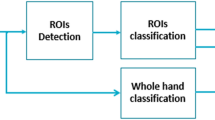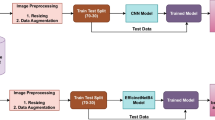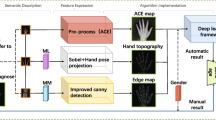Abstract
This study proposes an accurate method in assessing chronological age of the adolescents using a machine learning approach using MRI images. We also examined the value of MRI with Tanner-Whitehouse 3 (TW3) method in assessing skeletal maturity. Seventy-nine 12–17-year-old healthy Hong Kong Chinese adolescents were recruited. The left hand and wrist region were scanned by a dedicated skeletal MRI scanner. T1-weighted three-dimensional coronal view images for the left hand and wrist region were acquired. Independent maturity indicators such as subject body height, body weight, bone marrow composition intensity quantified by MRI, and TW3 skeletal age were included for artificial neural network (ANN) analysis. Our results indicated that the skeletal age was generally underestimated using TW3 method, and significant difference (p < 0.05) was noted for skeletal age with chronological age for female category and at later stage of adolescence (15 to 17 years old) in both genders. In our proposed machine learning approach, ages determined by ANN method agreed well with chronological age (p > 0.05).The machine learning approach using ANN method was about 10-fold more accurate than the TW3 method using MRI alone. It offers a more objective and accurate solution for prospective chronological maturity assessment for adolescents.





Similar content being viewed by others
References
Tscholl PM, Junge A, Dvorak J, Zubler V. MRI of the wrist is not recommended for age determination in female football players of U-16/U-17 competitions. Scand J Med Sci Sports. 2016 Mar;26(3):324–8. https://doi.org/10.1111/sms.12461. Epub 2015 Apr 16.
Sarkodie BD, Ofori EK, Pambo P. MRI to determine the chronological age of Ghanaian footballers. The South African Journal of Sports Medicine, Vol 25, No 3 (2013)
Schmeling A, Geserick G, Reisinger W, Olze A: Age estimation. Forensic Sci Int. 165(2–3):178–181, 2007 Jan 17 Epub 2006 Jun 19
Diz P, Limeres J, Salgado AF, Tomás I, Delgado LF, Vázquez E, Feijoo JF: Correlation between dental maturation and chronological age in patients with cerebral palsy, mental retardation, and Down syndrome. Res Dev Disabil. 32(2):808–817, 2011
Mughal AM, Hassan N, Ahmed A: Bone age assessment methods: A critical review. Pak J Med Sci 30:211–215, 2013
Dvorak J, George J, Junge A, Hodler J: Age determination by magnetic resonance imaging of the wrist in adolescent male football players. Br J Sports Med 41:45–52, 2007
George J, Nagendran J, Azmi K: Comparison study of growth plate fusion using MRI versus plain radiographs as used in age determination for exclusion of overaged football players. Br J Sports Med 46:273–278, 2012
Terada Y, Kono S, Tamada D, Uchiumi T, Kose K, Miyagi R, Yamabe E, Yoshioka H: Skeletal age assessment in children using an open compact MRI system. Magn Reson Med 69:1697–1702, 2013
Tomei E, Sartori A, Nissman D, al Ansari N, Battisti S, Rubini A, Stagnitti A, Martino M, Marini M, Barbato E, Semelka RC: Value of MRI of the hand and the wrist in evaluation of bone age: Preliminary results. J Magn Reson Imaging 39:1198–1205, 2014
Wikipedia: Artificial neural network. Retreived 15 December, 2017 from https://en.wikipedia.org/wiki/Artificial_neural_network.
Larson DB, Chen MC, Lungren MP, Halabi SS, Stence NV, Langlotz CP. Performance of a Deep-Learning Neural Network Model in Assessing Skeletal Maturity on Pediatric Hand Radiographs. Radiology Npv 2017.(ahead of print)
Bocchi L, Ferrara F, Nicoletti I, Valli G. An artificial neural network architecture for skeletal age assessment. In: Image Processing, 2003. ICIP 2003. Proceedings. 2003 International Conference on: IEEE, 2003:I-1077-1080 vol. 1071
Liu J, Qi J, Liu Z, Ning Q, Luo X: Automatic bone age assessment based on intelligent algorithms and comparison with TW3 method. Comput Med Imaging Graph 32:678–684, 2008
Pynsent P, Fairbank J, Carr A. Assessment Methodology in Orthopaedics: Butterworth-Heinemann Medical, 1997
So H-K, Nelson EA, Li AM et al.: Secular changes in height, weight and body mass index in Hong Kong children. BMC Public Health 8:1, 2008
Modlesky CM, Bajaj D, Kirby JT, Mulrooney BM, Rowe DA, Miller F: Sex differences in trabecular bone microarchitecture are not detected in pre and early pubertal children using magnetic resonance imaging. Bone 49:1067–1072, 2011
Terada Y, Kono S, Uchiumi T et al.: Improved reliability in skeletal age assessment using a pediatric hand MR scanner with a 0.3 T permanent magnet. Magn Reson Med Sci 13:215–219, 2014
Griffith JF, Cheng JCY, Wong E: Are western skeletal age standards applicable to the Hong Kong Chinese population? A comparison of the Greulich and Pyle method and the Tanner and Whitehouse method. Hong Kong Medical Journal 13:28–32, 2007
Ortega AI, Haiter-Neto F, Ambrosano GMB, Bóscolo FN, Almeida SM, Casanova MS: Comparison of TW2 and TW3 skeletal age differences in a Brazilian population. Journal of Applied Oral Science 14:142–146, 2006
Ahmed ML, Warner JT: TW2 and TW3 bone ages: Time to change? Arch Dis Child 92:371–372, 2007
Bull RK, Edwards PD, Kemp PM, Fry S, Hughes IA: Bone age assessment: A large scale comparison of the Greulich and Pyle, and Tanner and Whitehouse (TW2) methods. Arch Dis Child 81:172–173, 1999
Khan K, Elayappen AS. Bone growth estimation using radiology (Greulich–Pyle and Tanner–Whitehouse methods). In: Handbook of Growth and Growth Monitoring in Health and Disease: Springer, 2012:2937–2953
Tu JV: Advantages and disadvantages of using artificial neural networks versus logistic regression for predicting medical outcomes. J Clin Epidemiol 49:1225–1231, 1996
Kim JR, Shim WH, Yoon HM, Hong SH, Lee JS, Cho YA, Kim S: Computerized bone age estimation using deep learning based program: Evaluation of the accuracy and efficiency. AJR Am J Roentgenol. 209(6):1374–1380, 2017 Dec. https://doi.org/10.2214/AJR.17.18224
Hagan MT, Menhaj MB: Training feedforward networks with the Marquardt algorithm. Neural Networks, IEEE Transactions on 5:989–993, 1994
Acknowledgements
Our thanks go to the students Chan Yiu Cheong, Chung Chin Pok, Kwok Man Yin, and Yim Ming Yeung who participated in this project.
Funding
This project is partially funded by the departmental one-line budget for Final Year Project of the Hong Kong Polytechnic University.
Author information
Authors and Affiliations
Corresponding author
Ethics declarations
Ethics approval was also obtained from the University Research Ethics Committee.
Conflict of Interest
The authors declare that they have no conflict of interest.
Rights and permissions
About this article
Cite this article
Tang, F.H., Chan, J.L. & Chan, B.K. Accurate Age Determination for Adolescents Using Magnetic Resonance Imaging of the Hand and Wrist with an Artificial Neural Network-Based Approach. J Digit Imaging 32, 283–289 (2019). https://doi.org/10.1007/s10278-018-0135-2
Published:
Issue Date:
DOI: https://doi.org/10.1007/s10278-018-0135-2




